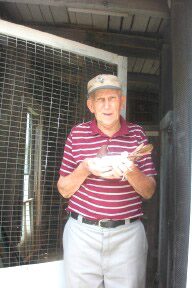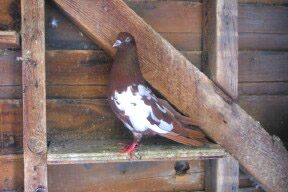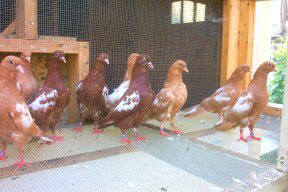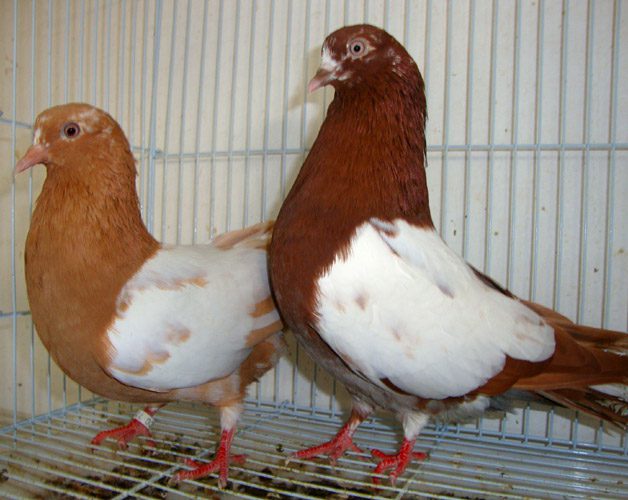Alan Bliven on his website has a couple of articles on the Hubbs rollers. He was a close friend of Charlies Hubbs and we thank him for sharing these articles,
My friend Les Manz and how I turned his Karp and Bygraves families into Mottles and Whitesides.
by Charlie Hubbs

I am currently 85 years old and started in the pigeon hobby when my aunt, Rose Hurley, brought me two common youngsters that fell from the eves of her house in 1927. Shortly after that time, a local Ophthalmologist helped me to get a solid start in the hobby by giving me ten young Tipplers from his loft.
When I was 8 years old, I noticed a strange but beautiful looking grizzled pigeon that flew into my little loft while I was training my Tipplers. That Grizzled pigeon, I soon discovered, belonged to a Mr. Fred Alfred, who lived on the other side of town. Mr. Alfred came to my home to claim his pigeon and invited my father and me to his home to see his loft of roller pigeons. My father and I had never seen pigeons fly like these before. Flying, rolling, and spinning in the air. A sight I will never forget.
That same day as my father and I were visiting and watching these roller pigeons perform, a gentleman named Les Manz walked into Mr. Alfred’s yard, it was obvious they were old friends. Les Manz was in the process of moving with his young wife to a new home located here in Riverside, New Jersey. Mr. Manz was actively in the process of moving into his new quarters and as he was very short on space for all of his pigeons; Les offered, and then gave me approximately 20 pigeons, mostly Frank Buehnor’s family that he purchased from Cleveland, Ohio. This was the very first time I ever met Les Manz.
As luck would have it, Les Manz moved into a home-located just two streets away from me. We became fast friends and we would visit each other’s homes often. We were together nearly every Saturday and Sunday, as my parents would permit.
We would talk about pigeons constantly and Les became a great mentor to me in the hobby. We would take turns sitting for hours in either his yard or at my parent’s yard watching our kits fly. Sometimes our kits would literally join up with each other while performing in the sky. That was a wonderful sight to see.
In 1934, Les Manz and Frank Sinkleris (whom in 1947 would become my supervisor at work and also was from Riverside, New Jersey). Purchased and bought out the famous Arthur Karp of Cleveland, Ohio. The Arthur Karp Birds were the old flying type of pigeon that would fly literally all day long, fly high, and which rolled deep. Les Manz decided to keep all of the Reds and Yellows, while Frank Sinkleris kept the Blues and Blacks from this Karp family.
It was about two years later when my best friend Les gave me my first Karp Pigeon. The bird was a Red Spangle cock that he was going to dispose of because the pigeon had acquired the disease canker. I was very excited at the time and told Les I could cure the bird using a medicine called Enhepin.
I carefully carried that pigeon home, treated the bird, and returned him back to Les the following week very healthy and totally disease free. Les told me to keep the pigeon, as he did not want any birds that were ever sick let back into his loft under any circumstance.
This Red Spangle cock was the foundation bird of the family I have to this day. Throughout the years Les has given me many of his birds from the Arthur Karp family of pigeons that he owned.
The Karp family of pigeons is a very high-strung breed. I can remember placing them of the loft roof for the beginning of their training process, to let them get accustomed to their surroundings. They would try to fly, only to land about, all scattered in the yard. We would run around the yard trying to catch them and place them back onto the loft roof. Repeatedly, we had to chase down and put the young birds back on the loft roof. I am quite sure we provided many hours of entertainment for our neighbors.
After a few days of this training, I would let them out and they would all stand in line on the very edge of the roof, waiting for the least little sound or movement that would spook them and send them scurrying up into the air. Being the very high-strung pigeons as they were I would constantly loose a number of them.
Les also purchased another family of pigeons from an Englishman named Joseph Bygraves from Camden, New Jersey. These pigeons were the Whittingham strain of pigeon. Bygraves would never sell any of his birds, but because of their friendship, he did give Les a few birds from his very exclusive family.
Les eventually purchased Bygraves entire family of pigeons after Mr. Bygraves passed away. Bygraves always flew his Whittingham family differently from the way Les did, and the way Les taught me to fly my pigeons. I saw Bygraves fly his family of pigeons many times through the years, as Les would take me to Bygraves house to watch them fly and learn about Bygraves birds.
Bygraves would always keep his birds hungry; so hungry indeed that if you threw a few grains of feed those pigeons would fight wildly over the seed, watching the kernels bouncing from pigeon to pigeon, before it was eventually eaten. Bygraves would also fly his pigeons several times in a day.
Conversely, Les would release his family of pigeons once daily and they would fly literally all day long and fly very high. Les, The genius that he was with rollers, decided to cross the two families together, the Karp and his newly acquired Bygraves birds.
I have received many of these crosses from him through the years. To my amazement, it was a beautiful sight to watch them in the air. The Karp when crossed with the Bygraves have become 100% easier to handle. The pigeons kitted very well together and would fly for hours with plenty of roll, even making breaks, which I never have seen from the Karp birds when Les flew them solely.

II) Changing this family from markings into Mottles and Whitesides.
As you recall, the first Red spangle cock that I received and cured of canker was the foundation bird of my family of pigeons. I mated a son from him with a Yellow hen that Les gave me. I bred two sets of Red Mottles from them. As soon as Les saw the mottles, he was amazed. Les thought the markings were beautiful and encouraged me to continue breeding them. I thought it over and with the assurance from Les, decided to create a family of these mottles. Les told me he never raised any mottles, and in all of the time I have known Les, I never saw a Mottle in his loft.
I kept crossing the pigeons with one another and every so often, I would get a mottle in either Red or Yellow. Both of the original Karp and Bygraves crossed birds were marked with beards, spangles, bald, piebald, rosewing, etc. all mixed patterns.
It has taken me over 30 years of breeding this family before I could confidently say I have a loft of Mottles and Whitesides. Through the process of inbreeding these mottles, I also get Whitesides from them, but they are not in perfect marking.
In the very beginning, when I started breeding the Mottles, I want to mention that Chandler Grover, who lived close to me at the time, also helped and gave me some Reds and Yellows that were from the Les Manz family that I used in my breeding project.
Originally, the Les Manz birds had all colors in their eyes; yellows, orange, bull, pearl, etc. However, by inbreeding for all of these years I get nothing other than straight gravel grey, pearl eyes. This family has produced only gravel grey, pearl eyes for the past sixty years, and they only produce Reds and Yellows.

III) The sad part.
My best friend and mentor Les Manz passed away in the winter of 1976. I remember clearly, when he called me on a Monday to come to his house and take possession all of his flyers, as he could no longer take care of them. Les has fallen on the ice three times the previous week and was very ill. I told Les I would hold his birds for him until spring when he would probably feel better. Les said no, that he was not going to get any better. Les passed away the end of that week on a Saturday.
During the week, just before his death, actually it was the same day I took possession of Les’s flyers, He also asked me to crate up all of his breeders and then asked me to take them all over to his brother Russell who lived nearby, which I promptly did.
I have the same original blood family of birds that Les gave me throughout the many years in my Mottles. This after 30 years of dedication and very hard work has become a solidly established family. After working all of these years of producing Mottles, I did not want to start all over again trying to produce Mottles from Les’s flying team. While speaking with my friend Chandler Grover, he stated he was interested in taking Les’s flyers, so I shipped them all to him in California.
After the many great years of being best of friends with Les Manz (1928-1976), I hope to continue to keep his family of pigeons as long as I can physically take care of them.
I can only hope that my friend Bill Latham, also of New Jersey, will keep and carry on this wonderful family of pigeons long after I am gone.
For all of the years I owned these birds, I have never put a cross into this family. All of the young continue to flourish healthy and without any defects. They still roll deep, will fly high, and continue on the wing for hours.
I want it made clear, and to be known;
1) I do not ship any pigeons.
2) This article is not to promote sales of any kind.
Respectfully Submitted,
Charles J. Hubbs

The Heritage of my NAHF Rollers
by William Latham
The true North American High flying Roller first appeared in the loft of George Stevens of Toronto, Canada in 1869. Stevens was known to breed for high quality, fine color, vivid markings, and most importantly their ability to fly high, fly long, and to roll deep.
A well-known fancier and authority on pigeons, named Arthur Karp from Cleveland, Ohio purchased these rollers from Stevens in the 1870’s.
In 1883, Arthur Karp, it is noted had crossed his Stevens birds with red and yellow Gansel Komorners. Karp was credited for creating a fabulous line of Red and yellow spangles from this combination.
The resulting pigeons were of a longer cast, very leggy, and became a much stronger pigeon all around. Possessing plenty of vigor, known to be extremely hyperactive, and carry exceptional aerial strength. These birds flew 6 to 8 hours or more. In addition, would roll very deep 50 to 100 feet. Nevertheless, were very difficult pigeons to settle or control.
About 1890, the Whittingham strain had arrived in Canada. The Whittingham strains were imported into the United States from 1890 to 1915. The Whittingham rollers had a reputation for being outstanding high and long flyers. Many rollers found in the United States and throughout Canada until 1930 were referred to as being of this Whittingham strain. Many of the Whittingham birds imported into the USA, from 1901 to 1909, had come from J. McAree of Toronto, Canada. Many roller fanciers began to cross Whittingham blood into their birds to increase stamina and endurance.
Notably one of these fanciers known to have an exceptionally fine family of Whittingham families during the 1920’s was an Englishman named Joseph Bygraves from Camden, New Jersey. Bygraves was known for never parting with any of his fine birds. Bygraves did fly his birds several times a day and continued in the English tradition of keeping the pigeons very hungry. These were much different feeding and flying methods used from the standard of the day.
It was in 1934 when Lester Manz and Frank Sinkleris both from Riverside, New Jersey, Purchased and bought out the famous Author Karp of Cleveland, Ohio. Les Manz decided to keep all of the reds and yellows, while Frank Sinkleris kept the blues and blacks from this Karp family.
Les Manz also purchased another family of pigeons from his long time friend Joseph Bygraves after his passing.
Whereas, Lester Manz, the genius that he was with rollers, decided to cross the two families of Karp and Bygraves together. The Karp when crossed with the Bygraves had become 100% easier to handle. These very intelligent pigeons kitted very well together and would fly for hours with plenty of roll, even making breaks never before seen from the original Karp birds.
It was in 1936 that a long time friend and student of Lester Manz, named Charles Hubbs, whom also resided in Riverside, New Jersey, began his long journey of creating Mottles and Whitesides from the original Lester Manz strain of rollers.
Charlie Hubbs was given a red spangle cock that Les Manz was going to dispose of because the bird had acquired the disease canker. Excited to show his expertise in pigeons and impress Les Manz, the young Charlie Hubbs used a medicine called Enhepin. Charlie Hubbs carried the sick bird home, treated the pigeon, and returned it to Les Manz a week later very healthy and totally disease free. Les Manz then told the young Charlie Hubbs to keep the pigeon since he would never let any bird that was ever sick back into his loft under any circumstances.
That red spangle was the very foundation bird of the family Charlie Hubbs has to this very day. Through the years, Les Manz has given Charlie many of his Karp and Bygraves cross birds. Charlie Hubbs mated that red mottle with a yellow hen which Les Manz gave him and produced a cock bird. Charlie bred two sets of red mottles from them. When Les Manz first seen the mottles he was amazed, and then encouraged Charlie to continue breeding them.
It has taken Charlie Hubbs over 30 years of dedicated breeding of this family before he would confidently say he has a loft full of Mottles and Whitesides. It was through the very process of inbreeding these Mottles, where Charlie will get Whitesides from them, but not in perfect markings.
However, by inbreeding this family for many years, Charlie produces nothing other than straight gravel grey pearl eyes, and only reds and yellows for the past 60 years.
For all of the years that Charlie Hubbs owned these birds he has never put a cross into this family. All of the young continue to flourish healthy and without any defects. Charlie Hubbs birds still roll deep, will fly high, and continue on the wing literally for hours.
Most American Rollermen in the beginning of the 20th century selected and bred their quality rollers for a long time on the wing, high flying, and with very deep roll. The North American Roller ruled the skies over all of North America with very little effort until about 1940, when word of William Pensom of England began to export his famous strain of Birmingham Rollers. This is another story, for another time.
A brief description of The North American Roller pigeon is of a medium size frame, with a weight of 8 to 12 ounces. The body is short in stature, longer in the keel with a full chest, carrying a proportionally oval shape head, with a stout neck that gradually tapers down to the shoulders.
A flesh color, medium size beak with very fine white wattles that are not overly pronounced. Gravel grey pearl eyes. Clean legs, with flesh color toenails. Possesses a tail with 12 feathers only, wings carried above the tail, and the wingtips measure ¾” before the tail, and a full chest. Colors are red, yellow, black, blue, and dun. With markings of saddles, beards, baldhead, rosewing, bell neck, spangles, mottles, and Whitesides.
The owner’s instruction manual* that came with my family of NAHF rollers states;
Breeders are to be fed strictly commercial high protein (17%) maintenance Turkey pellets. Occasionally commercial pigeon feed mixture is added later to allow adults to show squeakers how to eat properly.
All of my flyers are fed the same 17% protein maintenance Turkey pellets and a high protein commercial pigeon feed mixed at a 50/50 ratio.
During the winter month’s whole kernel corn, and safflower seed is added to supplement and increase fat content.
During the molting season, I add additional safflower seed to ease feather molting.
All food is freely fed and available to breeders, and flying kit. These pigeons are never kept hungry. They eat whatever amount they want daily.
Oyster shell grit with red grit added at a 50/50 mixture and kept in a separate bowl. Grit is available always.
Fresh water for drinking and bathing is available and changed frequently throughout the day.
(This particular family of pigeons has been fed straight turkey maintenance pellets for decades. Before the invention of pellets, a dry yellow powder called chicken mash was once used).
Training begins with those young birds that are able to feed themselves confidently and consistently. Training consists of allowing only the new very young birds to sit upon loft roof to learn their bearings and imprint the immediate area surrounding their loft. Times do vary, as these very young birds will fly up on their own accord or when something spooks them. Teaching to get them accustomed to the trap is another story, but I do leave a couple of bobs lifted up to allow a larger opening for them to pass thru more easily.
All the flyers are flown daily, preferably early AM, and are never allowed out after 12 noon. Birds are kept in the loft if inclement weather threatens.
I know you are asking yourself the question, “Why not fly the kit after 12 noon?” These birds will normally fly for 6 to 8 hours before returning to the loft for fresh water and feed.
I do not want them up flying when it begins to get dark, because they will stay up flying very high, and they will be attracted to the big city lights of Philadelphia, Pennsylvania, and may get lost.
Breeding within this family will take place when the local wild birds begin mating which is usually March or April, and only 2 to 3 rounds are bred per year. All breeding stops mid to late June to rest the birds.
The Les Manz family of pigeons were fed and trained for the past seven plus decades using these exact methods. I will continue in the same tradition, sticking to the old reliable phrase; “If it ain’t broken, don’t fix it”.
My Les Manz strain of birds will fly in excess of 1000 plus feet, occasionally disappearing into the clouds while circling high overhead the loft, again, depending on the weather conditions and the pigeons mood.
The roll and depth of roll from these birds is what everyone seems to care about most, it seems to peak the most interest. Well, let me try to explain.
“The Roll” you always read and hear about states; “is not as frequent, as the Birmingham”.
Not as frequent means, there are no short quick bursts of pigeons raining from the sky, only to quickly sweep up right back to the kit and perform again in very short order. These pigeons do roll in proper form, backwards at a high speed, but individually, for a very long depth of 100 feet or better. Since the roll is from a much greater height, and a longer distance, the pigeon must fly back up to reach the kit and it does take some additional time to accomplish this. These birds really enjoy rolling deep and are very stable.
Flying a 30, 50, or 100 bird kit and watching as each and every pigeon repeatedly drops and rolls at a phenomenal distance for literally hours is a sight and feeling that is sure to please any hard core competition roller flyer.
At one point, the NAHF Rollers were so wide spread on the continent they were perhaps the most dominant breed of roller in all of North America.
Today this pigeon breed has mostly died out and there are roughly a dozen or so dedicated breeders left in North America.
Please note: This article was written for informational purposes only, and is not intended to promote sales of any kind. I do not sell nor ship any pigeons.
Respectfully Submitted,
William Latham, III, RN, BSN, PHN
(AKA: Bill from NJ)
*My owner’s manual is actually my friend and mentor Charlie Hubbs.

